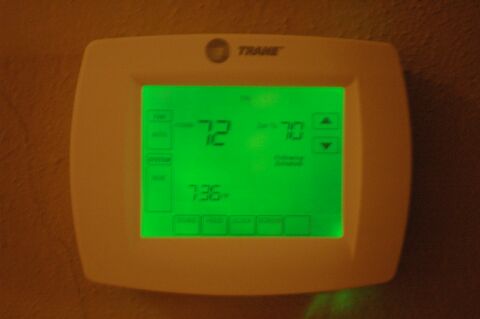With the winter season fast approaching for many of us, thoughts come to mind of things we can quickly and inexpensively do to save some energy (and cash) this winter. One of those ways is installing a programmable thermostat.
A programmable thermostat really is a great thing. Why, you ask? Because, it takes care of us and increases the comfort of your house. Why wake up to a cold house when you could have it heat up a short time before you get up? Its just one less thing you have to remember to do every morning and night.
But, thats not all, a programmable thermostat also helps save energy. It sets your house temperature based on a schedule you setup. It never forgets to turn the heat down (or up). Can you say that for yourself? I certainly can’t.
So, today we are looking at how to retrofit an older mechanical thermostat to a nice new programmable thermostat that we got from Trane. The XL800 thermostat will be replacing an old Honeywell manual thermostat. The whole process is very simple and pretty much anyone can do it.
The first step is to go turn off the furnace, boiler, heat pump, or whatever device heats or cools your home.
Next, we remove the old thermostat. For this specific thermostat, you first pull the outer bezel straight off. Then, unscrew the few screws holding it to the backing plate.
With the thermostat removed, unscrew the backing plate from the wall. Carefully pull the wires out a bit so you have room to work. Then, unscrew the wires from the backing plate. Be very careful not to let the wires fall back into the wall. If this happens, you have a lot more work on your hands.
Now, refer to the instructions on how to wire the new thermostat backing plate. Of course, the boiler I was working on is so old, the wiring for it isn’t included in the manual. However, a little bit of googling fixed that problem fairly quickly. With the new backing plate wired, you can mount it to the wall. Also, it is a good idea to pack the hole in the wall that the wires come through with something that will block air. Cold air could possibly come through the hole and throw off the thermostat’s temperature readings.
Thats really all there is too the physical installation. This installation would have taken less than 30 minutes had I not had to figure out the ancient wiring. You’d think two wires would be easy to figure out…
You of course have to program the thermostat now. I would just like to take a second to dispel the ever popular myth that ‘it takes more energy to reheat a cold house than to leave it warm’ is completely false and ridiculous. Physics laws specifically tell us that the greater the difference in temperature between the inside and outside, the greater the heat loss (or gain in summer). You keep the house warmer and it is going to loose more heat, period.
Once the thermostat is programmed, you can push it against the backing plate and it will snap into place and begin its scheduled programming.
Update: See the results of the thermostat install here.


{ 1 trackback }
{ 7 comments }
Thanks for the guide! Someone gave us a thermostat that we are dying to start using. I have a quick question. We have a boiler (like yourself). Do we need special thermostats? They were using this thermostat for their furnace. Will it still work? The back says, not compatible with any 120/240V circuit. Cheers, -DC
Dan,
The Trane thermostat was installed and was working fine the night I installed it. I have not followed up with the people to see how well it has been working for them. The main concern I had was that the boiler would heat up the radiators and heat the room up to the temperature it was set at. The thermostat would then turn off the boiler, but the radiators would still be quite hot and the room would continue to heat up. I am going to let them use the thermostat for a few weeks and then I will be doing a review on the product. I’ll tell of any problems we run into and solutions we find.
Without looking at your thermostat I can’t say with absolute certainty if it would work or not. However, I would imagine that it would work on your boiler. They seem to be setup to handle most any heating/cooling system.
Hi,
When you dispose of the old thermostat, you really must find a way to recycle it; as it has like 3,000mg of the stuff in the switch. (This is enough to make nearly 1,000 CFL bulbs!) It is worth money to someone — my local Aubuchon hardware store takes back fluorescent bulbs so they can reclaim the mercury, so there is a good chance they would take the thermostat, too?
Sincerely, Neil
so i’ve been loving the series but are there any before and afters on the energy bills or do we just get to assume you’re useing less….. or more?
We are currently gathering data. There will be a follow up review once we are sure of the results.
how may wires are to hook up and what wires go what.
Bob,
It all depends on what kind of heating system you have. The instructions that come with the thermostat cover the most common ones. For the others, a little googling will give you the answer.
Comments on this entry are closed.